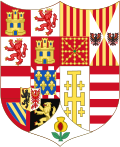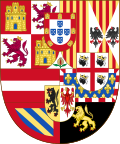Gallery
| Versions of the Spanish Royal Arms used by the Monarch as Sovereign of Naples and Sicily | |||||||||
| Coat of Arms | Dates and Monarch | Details | |||||||
|---|---|---|---|---|---|---|---|---|---|
| Philip of Spain Prince of Asturias and Girona 1554–1556 Philip II 1556–1598 |
| ||||||||
| Philip III 1598–1621 Philip IV 1621–1665 |
| ||||||||
Charles II 1665–1700 |
| ||||||||
Philip V 1700–1713 |
| ||||||||
| Version of the Spanish Royal Arms used by the Monarch as Sovereign of Sicily | |||||||||
| Coat of Arms | Dates | Details | |||||||
|---|---|---|---|---|---|---|---|---|---|
Philip II 1580–1598 Philip I, as King of Portugal 1580–1598 Philip III/II 1598–1621 Philip IV 1621–1665 Philip III as King of Portugal 1621–1640 Charles II 1665–1700 |
| ||||||||
Philip V 1700–1713 |
| ||||||||
| Versions of the Spanish Royal Arms used by the Monarch as Sovereign of Milan | ||||||||||
| Coat of Arms | Dates and Monarch | Details | ||||||||
|---|---|---|---|---|---|---|---|---|---|---|
Philip of Spain Prince of Asturias and Girona 1554–1556 Philip II 1556–1558 King jure uxoris of England and Ireland 1554–1558 |
| |||||||||
Philip II 1558–1580 |
| |||||||||
Philip II 1580–1598 Philip I, as King of Portugal 1580–1598 Philip III/II 1598–1621 Philip IV 1621–1665 Philip III as King of Portugal 1621–1640 Charles II 1665–1700 |
| |||||||||
| Philip V 1700–1706/1713 |
| |||||||||
| Versions of the Spanish Royal Arms used by the Monarch as Sovereign of Sardinia | |||||||||
| Coat of Arms | Dates and Monarch | Details | |||||||
|---|---|---|---|---|---|---|---|---|---|
| Philip I , II , III and Charles II as King of Sardinia 1580–1700 |
| ||||||||
























